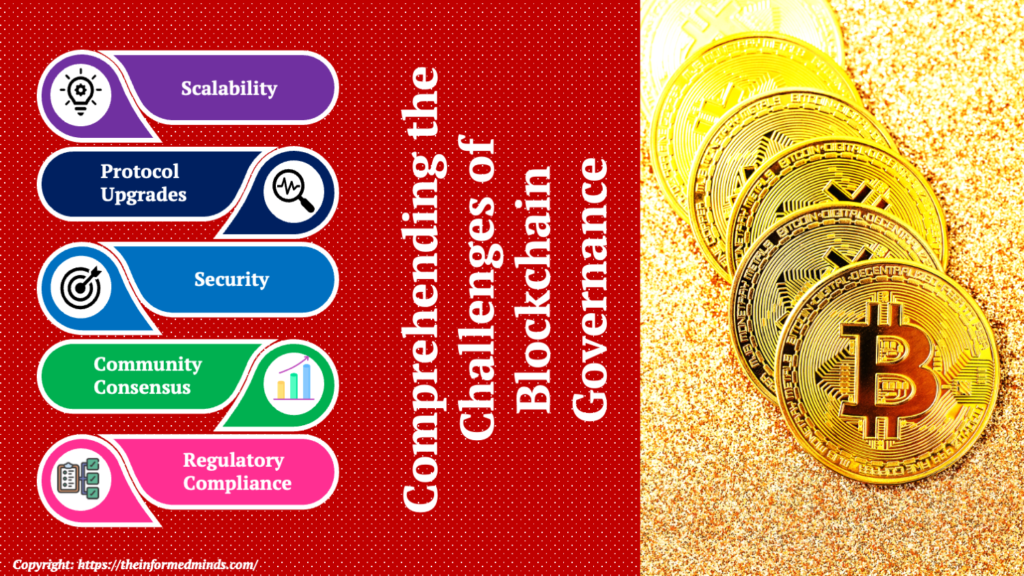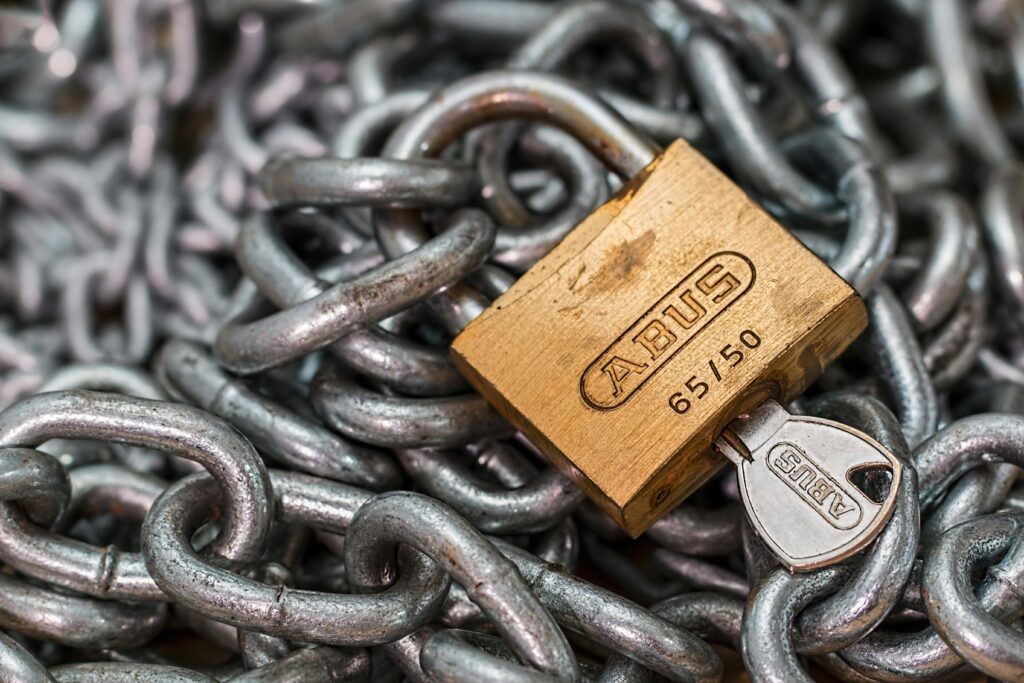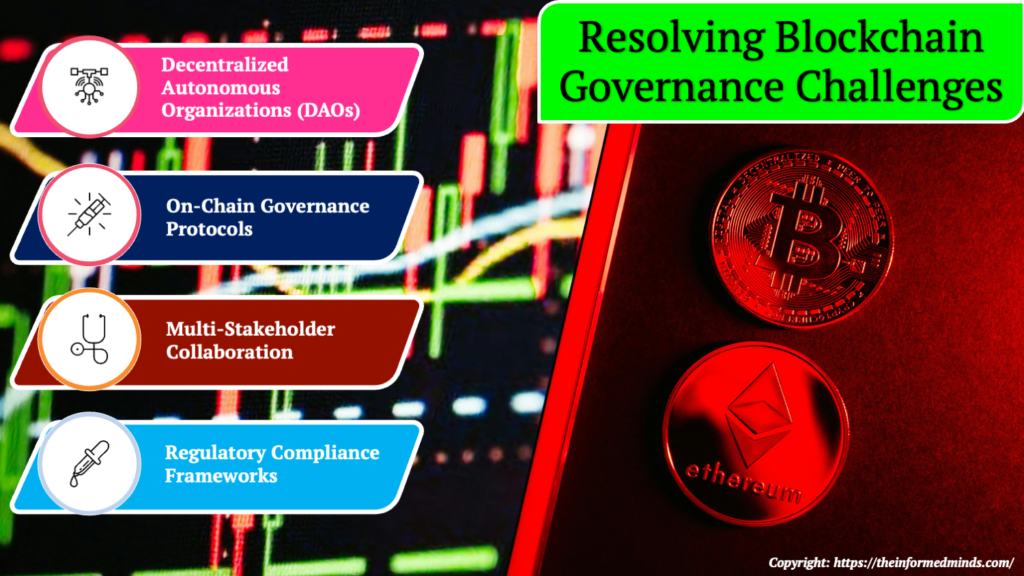To Share is to Show You Care!
In the fast-paced world of blockchain technology, governance stands as a pivotal challenge. As the decentralized ecosystem evolves, addressing governance issues becomes imperative for sustained growth and innovation. In this article, we delve into effective solutions to blockchain governance challenges, offering insights into creating resilient decentralized systems.
1. Understanding Blockchain Governance Challenges

1.1 Scalability

Scalability refers to a blockchain’s ability to handle an increasing number of transactions as the network grows. The decentralized nature of blockchain poses challenges in achieving high throughput without sacrificing decentralization and security. As more users join the network, transaction processing times may increase, leading to delays and higher costs. Solutions such as sharding, layer 2 solutions, and consensus algorithm improvements aim to enhance scalability without compromising decentralization.
1.2 Protocol Upgrades
Protocol upgrades are necessary to introduce new features, fix bugs, and enhance security in blockchain networks. However, implementing changes without disrupting network consensus is challenging. Forks, both hard and soft, can lead to community fragmentation and undermine trust in the network. Effective governance mechanisms are needed to coordinate and execute protocol upgrades transparently, involving key stakeholders in decision-making processes.

1.3 Security

Security is paramount in blockchain networks to prevent unauthorized access, data breaches, and malicious activities such as double-spending and 51% attacks. Weaknesses in smart contracts, consensus algorithms, and network architecture can expose vulnerabilities that compromise the integrity of transactions. Robust security measures, including cryptographic algorithms, peer-reviewed code, and continuous security audits, are essential to mitigate risks and safeguard user assets.
1.4 Community Consensus
Achieving consensus among diverse stakeholders is essential for effective governance in blockchain networks. Disagreements over proposed changes, distribution of governance power, and conflicting interests can hinder consensus-building efforts. Transparent communication, inclusive decision-making processes, and mechanisms for resolving disputes are crucial for fostering community consensus and maintaining trust in decentralized networks.

1.5 Regulatory Compliance

Navigating regulatory frameworks presents a significant challenge for blockchain projects seeking to operate within legal boundaries while preserving decentralization. Regulatory uncertainty, compliance costs, and conflicting regulatory requirements across jurisdictions pose barriers to adoption and innovation. Collaborating with legal experts, engaging with regulatory authorities, and implementing compliance measures early in the development process can help mitigate regulatory risks and build trust with users and stakeholders.
2. Solutions to Blockchain Governance Issues

2.1 Decentralized Autonomous Organizations (DAOs)
DAOs leverage blockchain technology to automate decision-making processes and enable decentralized governance. Smart contracts encode rules and protocols that govern DAO operations, enabling transparent and auditable decision-making without centralized control. Token voting mechanisms empower stakeholders to participate in governance decisions based on their proportional ownership of governance tokens, fostering a sense of ownership and accountability within the community.
2.2 On-Chain Governance Protocols
On-chain governance protocols enable stakeholders to propose, discuss, and vote on changes to blockchain protocols directly on the blockchain. Governance tokens represent voting power and enable token holders to influence decision-making processes. Timelocks impose delays on proposed changes, allowing stakeholders to review and assess the potential impact before implementation. Transparent voting mechanisms and governance processes enhance accountability and trust among network participants.
2.3 Multi-Stakeholder Collaboration
Multi-stakeholder collaboration involves fostering cooperation among diverse stakeholders, including developers, users, miners, investors, and regulatory authorities. Aligning incentives, promoting interoperability, and standardizing protocols across blockchain networks can facilitate collaboration and consensus-building efforts. By engaging with stakeholders from different backgrounds and perspectives, blockchain projects can address common challenges and promote innovation in the decentralized ecosystem.
2.4 Regulatory Compliance Frameworks
Developing robust regulatory compliance frameworks is essential for blockchain projects to operate legally and sustainably in a rapidly evolving regulatory landscape. Compliance mechanisms, such as Know Your Customer (KYC) procedures and Anti-Money Laundering (AML) policies, help mitigate legal risks and ensure adherence to regulatory requirements. Collaboration with legal experts, proactive engagement with regulators, and ongoing education and awareness initiatives empower blockchain projects to navigate regulatory challenges effectively and build trust with users and stakeholders.
In summary, understanding the challenges and implementing effective solutions are crucial steps towards achieving robust governance in blockchain networks. By addressing scalability issues, facilitating protocol upgrades, enhancing security measures, fostering community consensus, and embracing regulatory compliance, blockchain projects can navigate governance challenges and realize the full potential of decentralized technologies.
Conclusion
Effective governance is essential for the long-term viability and success of blockchain networks. By embracing decentralized autonomous organizations, implementing on-chain governance protocols, fostering multi-stakeholder collaboration, and adhering to regulatory compliance frameworks, blockchain ecosystems can overcome governance challenges and unlock their full potential.
In conclusion, addressing blockchain governance issues requires a multifaceted approach that prioritizes transparency, inclusivity, and innovation. As the blockchain landscape continues to evolve, proactive measures must be taken to ensure the resilience and adaptability of decentralized networks. Through collaborative efforts and strategic initiatives, the blockchain community can pave the way for a decentralized future built on trust, security, and scalability.
Frequently Asked Questions
Q1: What is the biggest problem with blockchain?
A: The biggest problem with blockchain is scalability. As the number of transactions increases, blockchain networks often struggle to handle the growing volume efficiently, leading to delays and higher costs.
Q2: What are the disadvantages of on-chain governance?
A: Disadvantages of on-chain governance include potential for centralization, slower decision-making processes due to on-chain voting mechanisms, and the risk of contentious hard forks if stakeholders cannot reach consensus.
Q3: What is the governance mechanism of the blockchain?
A: The governance mechanism of blockchain typically involves consensus algorithms, such as Proof of Work (PoW) or Proof of Stake (PoS), and governance protocols that dictate how decisions are made and implemented within the network.
Q4: What are the three dilemmas of blockchain?
A: The three dilemmas of blockchain often include scalability, security, and decentralization. Balancing these factors poses challenges for blockchain networks seeking to achieve widespread adoption and maintain trust among users.
Q5: Why blockchain is flawed?
A: Blockchain is flawed due to its limitations in scalability, security vulnerabilities, regulatory uncertainties, and challenges in achieving consensus among diverse stakeholders. These flaws hinder the widespread adoption and mainstream acceptance of blockchain technology.
Q6: What are the issues associated with blockchain?
A: Issues associated with blockchain include scalability, security vulnerabilities, regulatory compliance, governance challenges, interoperability issues, and energy consumption concerns associated with certain consensus mechanisms.
Q7: What is the chain governance structure?
A: Chain governance structure refers to the mechanisms and processes by which decisions are made and protocols are updated within a blockchain network. It often involves consensus mechanisms, governance protocols, and community participation in decision-making processes.
Q8: Why is chain governance needed?
A: Chain governance is needed to ensure transparency, accountability, and consensus among network participants in blockchain ecosystems. It facilitates decision-making processes, protocol upgrades, and dispute resolution, fostering trust and stability within the network.
Q9: Is supply chain a governance issue?
A: Yes, supply chain management involves governance issues related to transparency, traceability, and accountability throughout the supply chain network. Blockchain technology offers solutions to enhance supply chain governance by providing immutable records and enabling real-time visibility into transactions.
Q10: How does blockchain impact governance?
A: Blockchain impacts governance by introducing decentralized governance models, enabling transparent and auditable decision-making processes, and facilitating peer-to-peer transactions without the need for intermediaries. It enhances transparency, accountability, and efficiency in governance systems.
Q11: Who governs a blockchain?
A: The governance of a blockchain typically involves a decentralized network of stakeholders, including developers, miners, users, investors, and validators. Governance decisions are often made through consensus mechanisms and governance protocols agreed upon by the community.
Q12: How will blockchain change corporate governance?
A: Blockchain has the potential to revolutionize corporate governance by introducing transparent and auditable decision-making processes, enhancing shareholder engagement, and streamlining regulatory compliance. It can improve transparency, accountability, and efficiency in corporate governance structures.
Q13: What are some of the risks or drawbacks of blockchain technology?
A: Some risks or drawbacks of blockchain technology include scalability limitations, security vulnerabilities, regulatory uncertainties, energy consumption concerns, interoperability issues, and potential centralization risks associated with certain consensus mechanisms.
Q14: What are the primary attacks to blockchains?
A: Primary attacks to blockchains include 51% attacks, double-spending attacks, Sybil attacks, and consensus manipulation attacks. These attacks exploit vulnerabilities in blockchain networks to compromise transaction integrity and undermine network security.
Q15: Why is blockchain not scalable?
A: Blockchain is not scalable primarily due to the limitations of its consensus mechanisms and network architecture. As the number of transactions increases, blockchain networks face challenges in processing transactions efficiently while maintaining decentralization and security. Scalability solutions such as sharding and layer 2 protocols aim to address these limitations and improve network scalability.
The Informed Minds
I'm Vijay Kumar, a consultant with 20+ years of experience specializing in Home, Lifestyle, and Technology. From DIY and Home Improvement to Interior Design and Personal Finance, I've worked with diverse clients, offering tailored solutions to their needs. Through this blog, I share my expertise, providing valuable insights and practical advice for free. Together, let's make our homes better and embrace the latest in lifestyle and technology for a brighter future.

